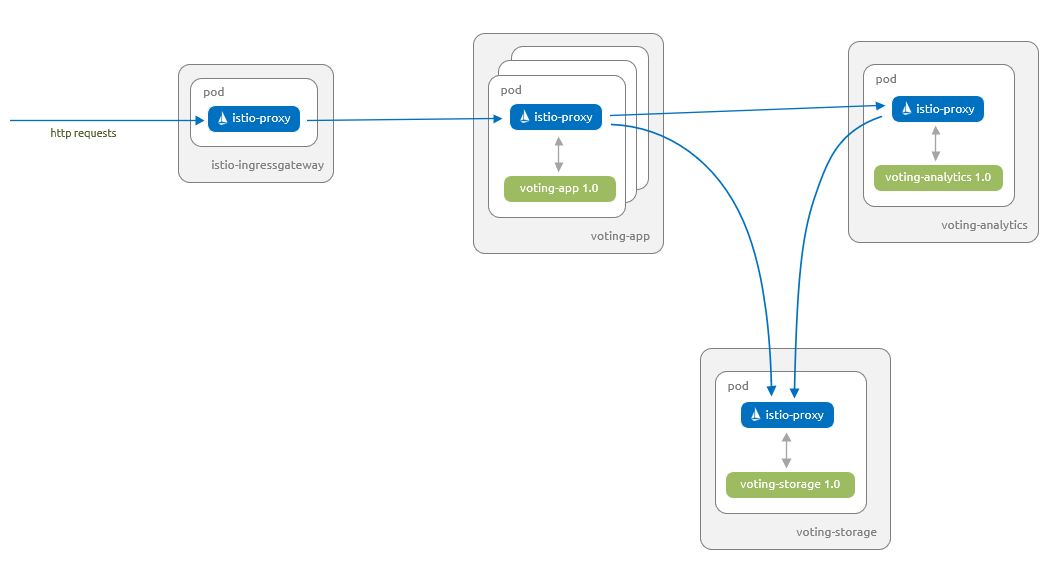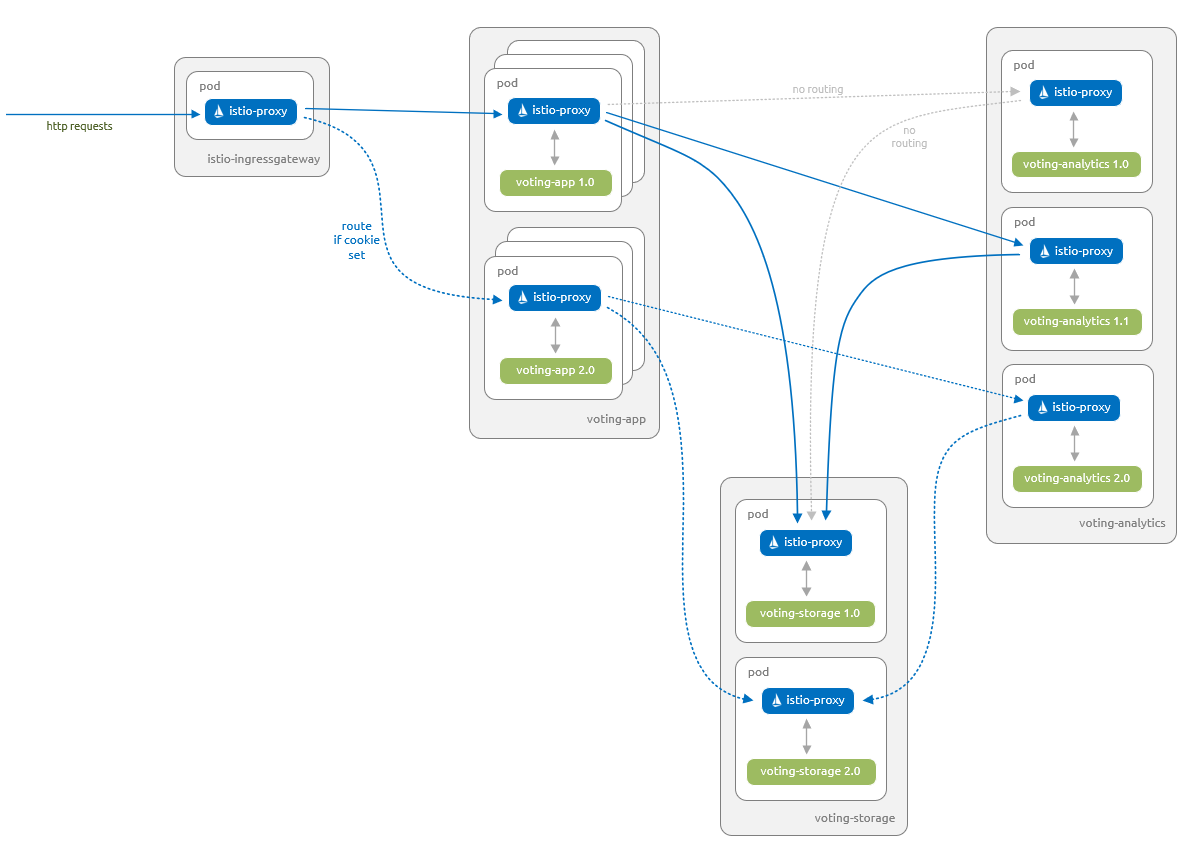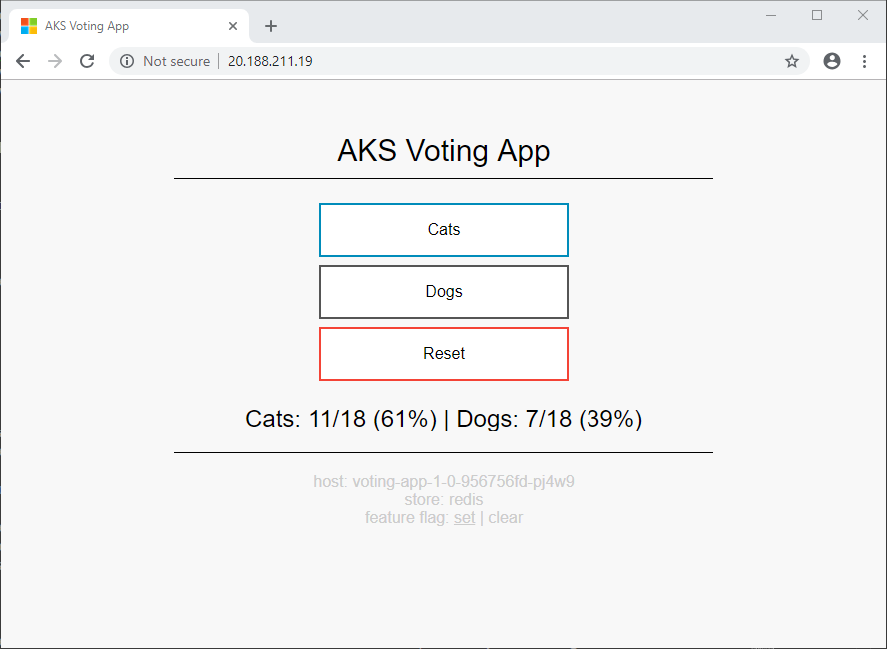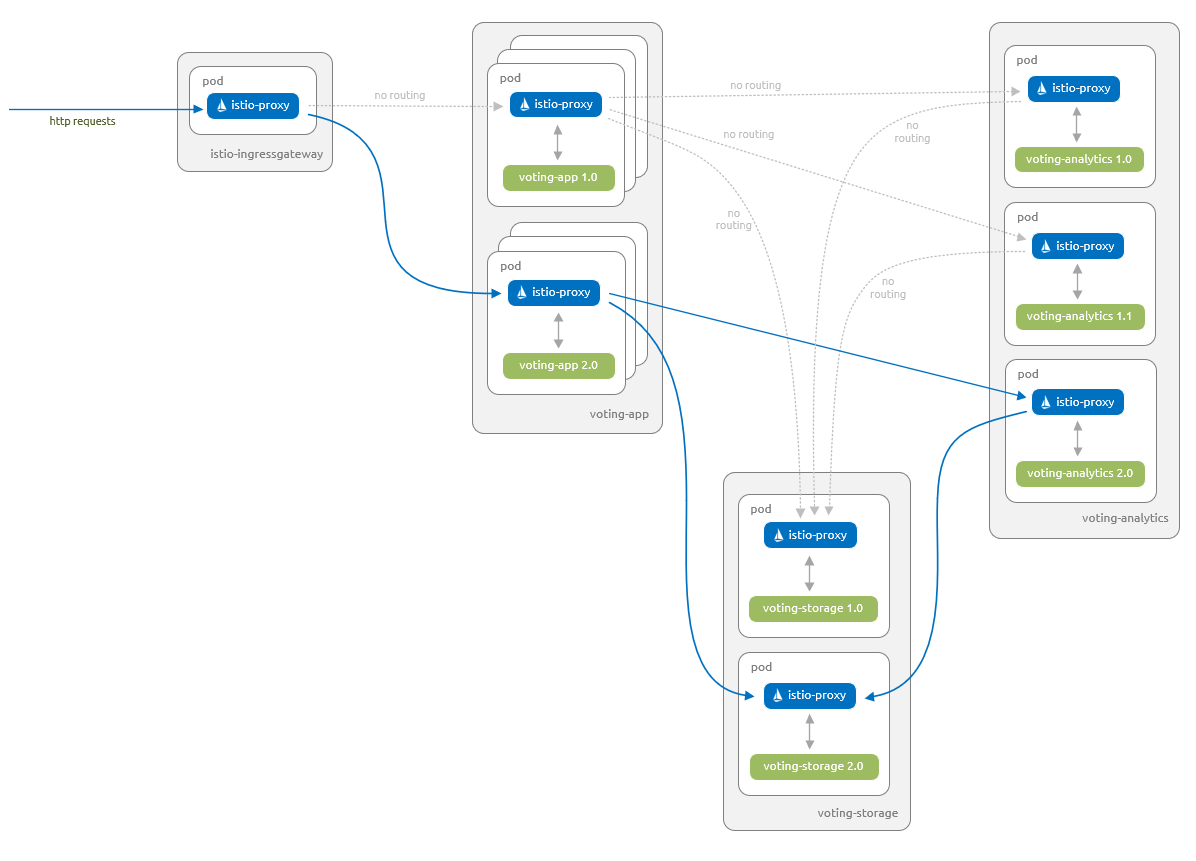Note
Access to this page requires authorization. You can try signing in or changing directories.
Access to this page requires authorization. You can try changing directories.
Istio is an open-source service mesh that provides a key set of functionality across the microservices in a Kubernetes cluster. These features include traffic management, service identity and security, policy enforcement, and observability. For more information about Istio, see the official What is Istio? documentation.
This article shows you how to use the traffic management functionality of Istio. A sample AKS voting app is used to explore intelligent routing and canary releases.
In this article, you learn how to:
- Deploy the application
- Update the application
- Roll out a canary release of the application
- Finalize the rollout
Before you begin
Note
This scenario has been tested against Istio version 1.3.2.
The steps detailed in this article assume you've created an AKS cluster (Kubernetes 1.13 and above, with Kubernetes RBAC enabled) and have established a kubectl connection with the cluster. You'll also need Istio installed in your cluster.
If you need help with any of these items, then see the AKS quickstart and Install Istio in AKS guidance.
About this application scenario
The sample AKS voting app provides two voting options (Cats or Dogs) to users. There is a storage component that persists the number of votes for each option. Additionally, there is an analytics component that provides details around the votes cast for each option.
In this application scenario, you start by deploying version 1.0 of the voting app and version 1.0 of the analytics component. The analytics component provides simple counts for the number of votes. The voting app and analytics component interact with version 1.0 of the storage component, which is backed by Redis.
You upgrade the analytics component to version 1.1, which provides counts, and now totals and percentages.
A subset of users test version 2.0 of the app via a canary release. This new version uses a storage component that is backed by a MySQL database.
Once you're confident that version 2.0 works as expected on your subset of users, you roll out version 2.0 to all your users.
Deploy the application
Let's start by deploying the application into your Azure Kubernetes Service (AKS) cluster. The following diagram shows what runs by the end of this section - version 1.0 of all components with inbound requests serviced via the Istio ingress gateway:

The artifacts you need to follow along with this article are available in the Azure-Samples/aks-voting-app GitHub repo. You can either download the artifacts or clone the repo as follows:
git clone https://github.com/Azure-Samples/aks-voting-app.git
Change to the following folder in the downloaded / cloned repo and run all subsequent steps from this folder:
cd aks-voting-app/scenarios/intelligent-routing-with-istio
First, create a namespace in your AKS cluster for the sample AKS voting app named voting as follows:
kubectl create namespace voting
Label the namespace with istio-injection=enabled. This label instructs Istio to automatically inject the istio-proxies as sidecars into all of your pods in this namespace.
kubectl label namespace voting istio-injection=enabled
Now let's create the components for the AKS Voting app. Create these components in the voting namespace created in a previous step.
kubectl apply -f kubernetes/step-1-create-voting-app.yaml --namespace voting
The following example output shows the resources being created:
deployment.apps/voting-storage-1-0 created
service/voting-storage created
deployment.apps/voting-analytics-1-0 created
service/voting-analytics created
deployment.apps/voting-app-1-0 created
service/voting-app created
Note
Istio has some specific requirements around pods and services. For more information, see the Istio Requirements for Pods and Services documentation.
To see the pods that have been created, use the kubectl get pods command as follows:
kubectl get pods -n voting --show-labels
The following example output shows there are three instances of the voting-app pod and a single instance of both the voting-analytics and voting-storage pods. Each of the pods has two containers. One of these containers is the component, and the other is the istio-proxy:
NAME READY STATUS RESTARTS AGE LABELS
voting-analytics-1-0-57c7fccb44-ng7dl 2/2 Running 0 39s app=voting-analytics,pod-template-hash=57c7fccb44,version=1.0
voting-app-1-0-956756fd-d5w7z 2/2 Running 0 39s app=voting-app,pod-template-hash=956756fd,version=1.0
voting-app-1-0-956756fd-f6h69 2/2 Running 0 39s app=voting-app,pod-template-hash=956756fd,version=1.0
voting-app-1-0-956756fd-wsxvt 2/2 Running 0 39s app=voting-app,pod-template-hash=956756fd,version=1.0
voting-storage-1-0-5d8fcc89c4-2jhms 2/2 Running 0 39s app=voting-storage,pod-template-hash=5d8fcc89c4,version=1.0
To see information about the pod, we'll use the kubectl describe pod command with label selectors to select the voting-analytics pod. We'll filter the output to show the details of the two containers present in the pod:
kubectl describe pod -l "app=voting-analytics, version=1.0" -n voting | egrep "istio-proxy:|voting-analytics:" -A2
The istio-proxy container has automatically been injected by Istio to manage the network traffic to and from your components, as shown in the following example output:
voting-analytics:
Container ID: docker://35efa1f31d95ca737ff2e2229ab8fe7d9f2f8a39ac11366008f31287be4cea4d
Image: mcr.microsoft.com/aks/samples/voting/analytics:1.0
--
istio-proxy:
Container ID: docker://1fa4eb43e8d4f375058c23cc062084f91c0863015e58eb377276b20c809d43c6
Image: docker.io/istio/proxyv2:1.3.2
kubectl describe pod -l "app=voting-analytics, version=1.0" -n voting | egrep "istio-proxy:|voting-analytics:" -A2
The istio-proxy container has automatically been injected by Istio to manage the network traffic to and from your components, as shown in the following example output:
voting-analytics:
Container ID: docker://35efa1f31d95ca737ff2e2229ab8fe7d9f2f8a39ac11366008f31287be4cea4d
Image: mcr.microsoft.com/aks/samples/voting/analytics:1.0
--
istio-proxy:
Container ID: docker://1fa4eb43e8d4f375058c23cc062084f91c0863015e58eb377276b20c809d43c6
Image: docker.io/istio/proxyv2:1.3.2
kubectl describe pod -l "app=voting-analytics, version=1.0" -n voting | Select-String -Pattern "istio-proxy:|voting-analytics:" -Context 0,2
The istio-proxy container has automatically been injected by Istio to manage the network traffic to and from your components, as shown in the following example output:
> voting-analytics:
Container ID: docker://35efa1f31d95ca737ff2e2229ab8fe7d9f2f8a39ac11366008f31287be4cea4d
Image: mcr.microsoft.com/aks/samples/voting/analytics:1.0
> istio-proxy:
Container ID: docker://1fa4eb43e8d4f375058c23cc062084f91c0863015e58eb377276b20c809d43c6
Image: docker.io/istio/proxyv2:1.3.2
You can't connect to the voting app until you create the Istio Gateway and Virtual Service. These Istio resources route traffic from the default Istio ingress gateway to our application.
Note
A Gateway is a component at the edge of the service mesh that receives inbound or outbound HTTP and TCP traffic.
A Virtual Service defines a set of routing rules for one or more destination services.
Use the kubectl apply command to deploy the Gateway and Virtual Service yaml. Remember to specify the namespace that these resources are deployed into.
kubectl apply -f istio/step-1-create-voting-app-gateway.yaml --namespace voting
The following example output shows the new Gateway and Virtual Service being created:
virtualservice.networking.istio.io/voting-app created
gateway.networking.istio.io/voting-app-gateway created
Obtain the IP address of the Istio Ingress Gateway using the following command:
kubectl get service istio-ingressgateway --namespace istio-system -o jsonpath='{.status.loadBalancer.ingress[0].ip}'
The following example output shows the IP address of the Ingress Gateway:
20.188.211.19
Open up a browser and paste in the IP address. The sample AKS voting app is displayed.

The information at the bottom of the screen shows that the app uses version 1.0 of voting-app and version 1.0 of voting-storage (Redis).
Update the application
Let's deploy a new version of the analytics component. This new version 1.1 displays totals and percentages in addition to the count for each category.
The following diagram shows what will be running at the end of this section - only version 1.1 of our voting-analytics component has traffic routed from the voting-app component. Even though version 1.0 of our voting-analytics component continues to run and is referenced by the voting-analytics service, the Istio proxies disallow traffic to and from it.

Let's deploy version 1.1 of the voting-analytics component. Create this component in the voting namespace:
kubectl apply -f kubernetes/step-2-update-voting-analytics-to-1.1.yaml --namespace voting
The following example output shows the resources being created:
deployment.apps/voting-analytics-1-1 created
Open the sample AKS voting app in a browser again, using the IP address of the Istio Ingress Gateway obtained in the previous step.
Your browser alternates between the two views shown below. Since you are using a Kubernetes Service for the voting-analytics component with only a single label selector (app: voting-analytics), Kubernetes uses the default behavior of round-robin between the pods that match that selector. In this case, it is both version 1.0 and 1.1 of your voting-analytics pods.


You can visualize the switching between the two versions of the voting-analytics component as follows. Remember to use the IP address of your own Istio Ingress Gateway.
INGRESS_IP=20.188.211.19
for i in {1..5}; do curl -si $INGRESS_IP | grep results; done
INGRESS_IP=20.188.211.19
for i in {1..5}; do curl -si $INGRESS_IP | grep results; done
$INGRESS_IP="20.188.211.19"
(1..5) |% { (Invoke-WebRequest -Uri $INGRESS_IP).Content.Split("`n") | Select-String -Pattern "results" }
The following example output shows the relevant part of the returned web site as the site switches between versions:
<div id="results"> Cats: 2 | Dogs: 4 </div>
<div id="results"> Cats: 2 | Dogs: 4 </div>
<div id="results"> Cats: 2/6 (33%) | Dogs: 4/6 (67%) </div>
<div id="results"> Cats: 2 | Dogs: 4 </div>
<div id="results"> Cats: 2/6 (33%) | Dogs: 4/6 (67%) </div>
Lock down traffic to version 1.1 of the application
Now let's lock down traffic to only version 1.1 of the voting-analytics component and to version 1.0 of the voting-storage component. You then define routing rules for all of the other components.
- A Virtual Service defines a set of routing rules for one or more destination services.
- A Destination Rule defines traffic policies and version specific policies.
- A Policy defines what authentication methods can be accepted on workload(s).
Use the kubectl apply command to replace the Virtual Service definition on your voting-app and add Destination Rules and Virtual Services for the other components. You will add a Policy to the voting namespace to ensure that all communicate between services is secured using mutual TLS and client certificates.
- The Policy has
peers.mtls.modeset toSTRICTto ensure that mutual TLS is enforced between your services within thevotingnamespace. - We also set the
trafficPolicy.tls.modetoISTIO_MUTUALin all our Destination Rules. Istio provides services with strong identities and secures communications between services using mutual TLS and client certificates that Istio transparently manages.
kubectl apply -f istio/step-2-update-and-add-routing-for-all-components.yaml --namespace voting
The following example output shows the new Policy, Destination Rules, and Virtual Services being updated/created:
virtualservice.networking.istio.io/voting-app configured
policy.authentication.istio.io/default created
destinationrule.networking.istio.io/voting-app created
destinationrule.networking.istio.io/voting-analytics created
virtualservice.networking.istio.io/voting-analytics created
destinationrule.networking.istio.io/voting-storage created
virtualservice.networking.istio.io/voting-storage created
If you open the AKS Voting app in a browser again, only the new version 1.1 of the voting-analytics component is used by the voting-app component.

You can visualize that you are now only routed to version 1.1 of your voting-analytics component as follows. Remember to use the IP address of your own Istio Ingress Gateway:
INGRESS_IP=20.188.211.19
for i in {1..5}; do curl -si $INGRESS_IP | grep results; done
INGRESS_IP=20.188.211.19
for i in {1..5}; do curl -si $INGRESS_IP | grep results; done
$INGRESS_IP="20.188.211.19"
(1..5) |% { (Invoke-WebRequest -Uri $INGRESS_IP).Content.Split("`n") | Select-String -Pattern "results" }
The following example output shows the relevant part of the returned web site:
<div id="results"> Cats: 2/6 (33%) | Dogs: 4/6 (67%) </div>
<div id="results"> Cats: 2/6 (33%) | Dogs: 4/6 (67%) </div>
<div id="results"> Cats: 2/6 (33%) | Dogs: 4/6 (67%) </div>
<div id="results"> Cats: 2/6 (33%) | Dogs: 4/6 (67%) </div>
<div id="results"> Cats: 2/6 (33%) | Dogs: 4/6 (67%) </div>
Let's now confirm that Istio is using mutual TLS to secure communications between each of our services. For this we will use the authn tls-check command on the istioctl client binary, which takes the following form.
istioctl authn tls-check <pod-name[.namespace]> [<service>]
This set of commands provide information about the access to the specified services, from all pods that are in a namespace and match a set of labels:
# mTLS configuration between each of the istio ingress pods and the voting-app service
kubectl get pod -n istio-system -l app=istio-ingressgateway | grep Running | cut -d ' ' -f1 | xargs -n1 -I{} istioctl authn tls-check {}.istio-system voting-app.voting.svc.cluster.local
# mTLS configuration between each of the voting-app pods and the voting-analytics service
kubectl get pod -n voting -l app=voting-app | grep Running | cut -d ' ' -f1 | xargs -n1 -I{} istioctl authn tls-check {}.voting voting-analytics.voting.svc.cluster.local
# mTLS configuration between each of the voting-app pods and the voting-storage service
kubectl get pod -n voting -l app=voting-app | grep Running | cut -d ' ' -f1 | xargs -n1 -I{} istioctl authn tls-check {}.voting voting-storage.voting.svc.cluster.local
# mTLS configuration between each of the voting-analytics version 1.1 pods and the voting-storage service
kubectl get pod -n voting -l app=voting-analytics,version=1.1 | grep Running | cut -d ' ' -f1 | xargs -n1 -I{} istioctl authn tls-check {}.voting voting-storage.voting.svc.cluster.local
# mTLS configuration between each of the istio ingress pods and the voting-app service
kubectl get pod -n istio-system -l app=istio-ingressgateway | grep Running | cut -d ' ' -f1 | xargs -n1 -I{} istioctl authn tls-check {}.istio-system voting-app.voting.svc.cluster.local
# mTLS configuration between each of the voting-app pods and the voting-analytics service
kubectl get pod -n voting -l app=voting-app | grep Running | cut -d ' ' -f1 | xargs -n1 -I{} istioctl authn tls-check {}.voting voting-analytics.voting.svc.cluster.local
# mTLS configuration between each of the voting-app pods and the voting-storage service
kubectl get pod -n voting -l app=voting-app | grep Running | cut -d ' ' -f1 | xargs -n1 -I{} istioctl authn tls-check {}.voting voting-storage.voting.svc.cluster.local
# mTLS configuration between each of the voting-analytics version 1.1 pods and the voting-storage service
kubectl get pod -n voting -l app=voting-analytics,version=1.1 | grep Running | cut -d ' ' -f1 | xargs -n1 -I{} istioctl authn tls-check {}.voting voting-storage.voting.svc.cluster.local
# mTLS configuration between each of the istio ingress pods and the voting-app service
(kubectl get pod -n istio-system -l app=istio-ingressgateway | Select-String -Pattern "Running").Line |% { $_.Split()[0] |% { istioctl authn tls-check $($_ + ".istio-system") voting-app.voting.svc.cluster.local } }
# mTLS configuration between each of the voting-app pods and the voting-analytics service
(kubectl get pod -n voting -l app=voting-app | Select-String -Pattern "Running").Line |% { $_.Split()[0] |% { istioctl authn tls-check $($_ + ".voting") voting-analytics.voting.svc.cluster.local } }
# mTLS configuration between each of the voting-app pods and the voting-storage service
(kubectl get pod -n voting -l app=voting-app | Select-String -Pattern "Running").Line |% { $_.Split()[0] |% { istioctl authn tls-check $($_ + ".voting") voting-storage.voting.svc.cluster.local } }
# mTLS configuration between each of the voting-analytics version 1.1 pods and the voting-storage service
(kubectl get pod -n voting -l app=voting-analytics,version=1.1 | Select-String -Pattern "Running").Line |% { $_.Split()[0] |% { istioctl authn tls-check $($_ + ".voting") voting-storage.voting.svc.cluster.local } }
This following example output shows that mutual TLS is enforced for each of our queries above. The output also shows the Policy and Destination Rules that enforces the mutual TLS:
# mTLS configuration between istio ingress pods and the voting-app service
HOST:PORT STATUS SERVER CLIENT AUTHN POLICY DESTINATION RULE
voting-app.voting.svc.cluster.local:8080 OK mTLS mTLS default/voting voting-app/voting
# mTLS configuration between each of the voting-app pods and the voting-analytics service
HOST:PORT STATUS SERVER CLIENT AUTHN POLICY DESTINATION RULE
voting-analytics.voting.svc.cluster.local:8080 OK mTLS mTLS default/voting voting-analytics/voting
HOST:PORT STATUS SERVER CLIENT AUTHN POLICY DESTINATION RULE
voting-analytics.voting.svc.cluster.local:8080 OK mTLS mTLS default/voting voting-analytics/voting
HOST:PORT STATUS SERVER CLIENT AUTHN POLICY DESTINATION RULE
voting-analytics.voting.svc.cluster.local:8080 OK mTLS mTLS default/voting voting-analytics/voting
# mTLS configuration between each of the voting-app pods and the voting-storage service
HOST:PORT STATUS SERVER CLIENT AUTHN POLICY DESTINATION RULE
voting-storage.voting.svc.cluster.local:6379 OK mTLS mTLS default/voting voting-storage/voting
HOST:PORT STATUS SERVER CLIENT AUTHN POLICY DESTINATION RULE
voting-storage.voting.svc.cluster.local:6379 OK mTLS mTLS default/voting voting-storage/voting
HOST:PORT STATUS SERVER CLIENT AUTHN POLICY DESTINATION RULE
voting-storage.voting.svc.cluster.local:6379 OK mTLS mTLS default/voting voting-storage/voting
# mTLS configuration between each of the voting-analytics version 1.1 pods and the voting-storage service
HOST:PORT STATUS SERVER CLIENT AUTHN POLICY DESTINATION RULE
voting-storage.voting.svc.cluster.local:6379 OK mTLS mTLS default/voting voting-storage/voting
Roll out a canary release of the application
Now let's deploy a new version 2.0 of the voting-app, voting-analytics, and voting-storage components. The new voting-storage component use MySQL instead of Redis, and the voting-app and voting-analytics components are updated to allow them to use this new voting-storage component.
The voting-app component now supports feature flag functionality. This feature flag allows you to test the canary release capability of Istio for a subset of users.
The following diagram shows what you will have running at the end of this section.
- Version
1.0of thevoting-appcomponent, version1.1of thevoting-analyticscomponent and version1.0of thevoting-storagecomponent are able to communicate with each other. - Version
2.0of thevoting-appcomponent, version2.0of thevoting-analyticscomponent and version2.0of thevoting-storagecomponent are able to communicate with each other. - Version
2.0of thevoting-appcomponent are only accessible to users that have a specific feature flag set. This change is managed using a feature flag via a cookie.

First, update the Istio Destination Rules and Virtual Services to cater for these new components. These updates ensure that you don't route traffic incorrectly to the new components and users don't get unexpected access:
kubectl apply -f istio/step-3-add-routing-for-2.0-components.yaml --namespace voting
The following example output shows the Destination Rules and Virtual Services being updated:
destinationrule.networking.istio.io/voting-app configured
virtualservice.networking.istio.io/voting-app configured
destinationrule.networking.istio.io/voting-analytics configured
virtualservice.networking.istio.io/voting-analytics configured
destinationrule.networking.istio.io/voting-storage configured
virtualservice.networking.istio.io/voting-storage configured
Next, let's add the Kubernetes objects for the new version 2.0 components. You also update the voting-storage service to include the 3306 port for MySQL:
kubectl apply -f kubernetes/step-3-update-voting-app-with-new-storage.yaml --namespace voting
The following example output shows the Kubernetes objects are successfully updated or created:
service/voting-storage configured
secret/voting-storage-secret created
deployment.apps/voting-storage-2-0 created
persistentvolumeclaim/mysql-pv-claim created
deployment.apps/voting-analytics-2-0 created
deployment.apps/voting-app-2-0 created
Wait until all the version 2.0 pods are running. Use the kubectl get pods command with the -w watch switch to watch for changes on all pods in the voting namespace:
kubectl get pods --namespace voting -w
You should now be able to switch between the version 1.0 and version 2.0 (canary) of the voting application. The feature flag toggle at the bottom of the screen sets a cookie. This cookie is used by the voting-app Virtual Service to route users to the new version 2.0.


The vote counts are different between the versions of the app. This difference highlights that you are using two different storage backends.
Finalize the rollout
Once you've successfully tested the canary release, update the voting-app Virtual Service to route all traffic to version 2.0 of the voting-app component. All users then see version 2.0 of the application, regardless of whether the feature flag is set or not:

Update all the Destination Rules to remove the versions of the components you no longer want active. Then, update all the Virtual Services to stop referencing those versions.
Since there's no longer any traffic to any of the older versions of the components, you can now safely delete all the deployments for those components.

You have now successfully rolled out a new version of the AKS Voting App.
Clean up
You can remove the AKS voting app we used in this scenario from your AKS cluster by deleting the voting namespace as follows:
kubectl delete namespace voting
The following example output shows that all the components of the AKS voting app have been removed from your AKS cluster.
namespace "voting" deleted
Next steps
You can explore additional scenarios using the Istio Bookinfo Application example.